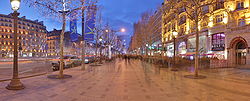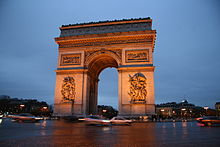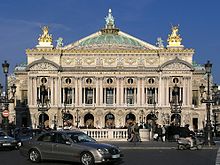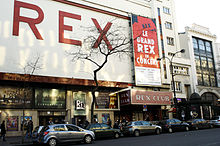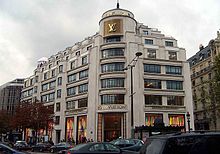- Culture of Paris
-
The Culture of Paris concerns the arts, music, museums, festivals and other entertainment in Paris, the capital city of France. The city is today one of the world's leading business and cultural centers; entertainment, music, media, fashion, and the arts all contribute to its status as one of the world's major global cities.
Paris is also home to notable cultural attractions such as the Louvre, Musée Picasso, Musée Rodin, Musée du Montparnasse, Musée National d'Art Moderne. Art and artifacts from the Middle Ages can be seen in Musée Cluny while Musée d'Orsay is notable for housing Impressionist era masterpieces.
A variety of landmarks and objects are cultural icons associated with Paris, such as Eiffel Tower, Notre Dame de Paris and Opéra Garnier. Many of Paris' once-popular local establishments have come to cater to the tastes and expectations of tourists, rather than local patrons. Le Lido, the cabaret-dance hall, for example, is a staged dinner theater spectacle, a dance display that was once but one aspect of the cabaret's former atmosphere. All of the establishment's former social or cultural elements, such as its ballrooms and gardens, are gone today. Much of Paris' hotel, restaurant and night entertainment trades have become heavily dependent on tourism.
Contents
Architecture
Main article: French architectureThe city's cathedrals are another main attraction: Its Notre Dame de Paris and the Basilique du Sacré-Coeur receive 12 million and eight million visitors, respectively. The Eiffel Tower, by far Paris' most famous monument, averages over six million visitors per year and more than 200 million since its construction.
Museums and galleries
Main article: List of museums in ParisParis' museums and monuments are among its highest-esteemed attractions; tourism has motivated both the city and national governments to create new ones. The city's most prized museum, the Louvre, welcomes over 8 million visitors a year, being by far the world's most-visited art museum. The Louvre is one of the largest and most famous museums, housing many works of art, including the Mona Lisa (La Joconde) and the Venus de Milo statue. Works by Pablo Picasso and Auguste Rodin are found in Musée Picasso and Musée Rodin, respectively, while the artistic community of Montparnasse is chronicled at the Musée du Montparnasse. Starkly apparent with its service-pipe exterior, the Centre Georges Pompidou, also known as Beaubourg, houses the Musée National d'Art Moderne. Art and artifacts from the Middle Ages and Impressionist eras are kept in Musée Cluny and Musée d'Orsay, respectively, the former with the prized tapestry cycle The Lady and the Unicorn. Paris' newest (and third-largest) museum, the Musée du quai Branly, opened its doors in June 2006 and houses art from Africa, Asia, Oceania, and the Americas.
Opera and theatres
Paris' largest opera houses are the nineteenth-century Opéra Garnier (historical Paris Opéra) and modern Opéra Bastille; the former tends towards the more classic ballets and operas, and the latter provides a mixed repertoire of classic and modern. In middle of 19th century, there were active two other competing opera houses: Opéra-Comique (which still exists to this day) and Théâtre Lyrique (which in modern times changed its profile and name to Théâtre de la Ville).
Theatre traditionally has occupied a large place in Parisian culture. This still holds true today; and many of its most popular actors today are also stars of French television. Some of Paris' major theatres include Bobino, Théâtre Mogador, and the Théâtre de la Gaîté-Montparnasse. Some Parisian theatres have also doubled as concert halls. Many of France's greatest musical legends, such as Édith Piaf, Maurice Chevalier, Georges Brassens, and Charles Aznavour, found their fame in Parisian concert halls: Legendary yet still-showing examples of these are Le Lido, Bobino, l'Olympia, la Cigale, and le Splendid.
The Élysées-Montmartre, much reduced from its original size, is a concert hall today. The New Morning is one of few Parisian clubs still holding jazz concerts, but the same also specialises in 'indie' music. In more recent times, the Le Zénith hall in Paris' La Villette[disambiguation needed
 ] quarter and a "parc-omnisports" stadium in Bercy serve as large-scale rock concert halls.
] quarter and a "parc-omnisports" stadium in Bercy serve as large-scale rock concert halls.Movies
See also: List of films set in ParisParisians tend to share the same movie-going trends as many of the world's global cities, that is to say with a dominance of Hollywood-generated film entertainment. French cinema comes a close second, with major directors (réalisateurs) such as Claude Lelouch, François Truffaut, Jean-Luc Godard, Claude Chabrol, and Luc Besson, and the more slapstick/popular genre with director Claude Zidi as an example.
European and Asian films are also widely shown and appreciated. A specialty of Paris is its very large network of small movie theatres: on a given week, the movie fan has the choice between around 300 old or new movies from all over the world.
Many of Paris' concert/dance halls were transformed into movie theatres when the media became popular from the 1930s. Later, most of the largest cinemas were divided into multiple, smaller rooms: Paris' largest cinema today is by far le Grand Rex theatre with 2,750 seats,[1] whereas other cinemas all have fewer than 1,000 seats. There is now a trend toward modern multiplexes that contain more than 10 or 20 screens.
Fashion
Paris has long been an international hub of fashion design. The city has produced many notable design houses, such as Chanel, Dior, Yves Saint Laurent, Chloé, Givenchy, Lanvin, Céline, Hermès, and Louis Vuitton. Paris also remains a premier destination for shopping, with streets such as Rue du Faubourg Saint-Honoré and the Champs-Élysées hosting boutiques from designers around the world. The city is generally considered to be part of the "big four" global fashion capitals, alongside Milan, London and New York City, and in 2011, the Global Language Monitor ranked Paris as the world's third top fashion capital.[2]
In addition to fashion and leather goods, Paris is home to a number of well-known jewelers, such as Cartier, Boucheron, Chaumet, and Van Cleef & Arpels. These and other jewelers have their flagships at the famed Place Vendôme.
Paris is home to a fashion week twice a year where the city's fashion houses present their collections. Additionally, designers from other countries may present their collections in Paris. Notable examples include Belgian designers Dries van Noten, Martin Margiela, and Ann Demeulemeester; Dutch design duo Viktor & Rolf; and Japanese deisgners Yohji Yamamoto, Issey Miyake, and Junya Watanabe.
The two major holding companies in contemporary fashion, Pinault-Printemps-Redoute and LVMH, are both headquartered in Paris.
Cuisine
 The Les Deux Magots cafe.
The Les Deux Magots cafe.
Paris' culinary reputation has its base in the diverse origins of its inhabitants. In its beginnings, it owed much to the 19th-century organisation of a railway system that had Paris as a centre, making the capital a focal point for immigration from France's many different regions and gastronomical cultures. This reputation continues through today in a cultural diversity that has since spread to an worldwide level thanks to Paris' continued reputation for culinary finesse and further immigration from increasingly distant climes.
Hotels were another result of widespread travel and tourism, especially Paris' late-19th-century Expositions Universelles (World's Fairs). Of the most luxurious of these, the Hôtel Ritz, appeared in the Place Vendôme from 1898, and the Hôtel de Crillon opened its doors on the north side of the place de la Concorde from 1909.
Recreation
Disneyland Resort Paris is a major tourist attraction not only for visitors to Paris but for visitors to the rest of Europe as well, with 14.5 million visitors in 2007.
Festivals and events
Several yearly festivals take place in Paris, such as Rock en Seine.
References
- ^ Time Out Guides Ltd, (2005), p.298
- ^ http://www.languagemonitor.com/?s=fashion+capital
- Vincent Cronin (1989). Paris on the Eve, 1900-1914. New York: Harper Collins. ISBN 0-312-04876-9.
- Vincent Cronin (1994). Paris:City of Light, 1919-1939. New York: Harper Collins. ISBN 0-00-215191-X.
- Jean Favier (1997-04-23) (in French). Paris. Fayard. ISBN 2-213-59874-6.
- Colin Jones (2004). Paris: The Biography of a City. New York: Penguin Viking. ISBN 0670033936.
- Rosemary Wakeman (2009). The Heroic City: Paris, 1945-1958. University of Chicago Press. ISBN 9780226870236.
- Time Out Guides Ltd, (2005), "Time Out Paris", Time Out Guides, ISBN 1904978304
External links
- Paris Nightlife
- Paris Nightlife (French)
Categories:- Paris culture
- French culture
Wikimedia Foundation. 2010.

